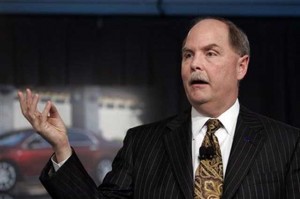
GM CEO Fritz Henderson (shown here) and Chrysler V.Chairman Jim Press faced a hostile Senate committee but held their ground on planned dealer cuts.
This time of year, it’s pretty hot and humid in Washington, D.C., but things were downright chilly, on Capitol Hill, if nonetheless sticky, when senior General Motors and Chrysler officials were put in the spotlight during a hearing on the planned cut, by the two makers, of nearly 3,000 U.S. car dealers.
“There’s been double-dealing going on,” proclaimed New Jersey Democrat Frank Lautenberg, as he suggested to GM CEO Fritz Henderson and Chrysler Vice Chairman Jim Press that they “must have a terrible conscience right now” for cutting so many dealers.
The wording was ironic, and more appropriate than Lautenberg might have intended, for the executives held their ground, during the tense session, insisting that they indeed do have double-dealing going on, with too many retailers chasing the same GM and Chrysler customers, and not spending enough of their time and energy trying to draw business away from the competition.
“This is our last chance to get it right,” said Henderson, “to fix permanently those parts of the business that have diverted us from consistently building winning cars and trucks and the consumer experience to math.”
According to Henderson, it costs about $1,000 per dealer in advertising and various other forms of support. Reducing the number of showrooms would cut that figure sharply, the industry claims, though dealer backers insist that retailers actually cost little, if anything, for the manufacturers.
 Dozens of dealers crowded into the hearing room for the session, some armed with a prototype piece of legislation, dubbed the “Automobile Dealer Economic Rights Restoration Act of 2009,” which they hoped would force the two bankrupt makers to reverse their planned dealer death sentences.
Dozens of dealers crowded into the hearing room for the session, some armed with a prototype piece of legislation, dubbed the “Automobile Dealer Economic Rights Restoration Act of 2009,” which they hoped would force the two bankrupt makers to reverse their planned dealer death sentences.
“Only our elected officials can correct our current course,” said Jack Fitzgerald, a Washington-area Chrysler dealer losing nearly a half-dozen showrooms as part of the cuts, in a mailing to potential supporters.
During his time before the Senate Commerce Committee, Chrysler’s Press insisted the decision to eliminate 789 stores was “the most difficult business decision” he has ever made. But Press has made numerous comparisons between what he describes as the bloated Chrysler retail system and the lean dealer network of his former employer, Toyota. Like other key Japanese marques, Toyota generates as much as three times as much business per outlet as Detroit’s makers and industry analysts insist that with higher margins, such Asian retailers are willing and able to put more money and resources into their stores.
“A large factor in our bankruptcy is an inefficient, ineffective dealer body,” Press told the Senate committee, making it clear there would be no reversal of course, though both Chrysler and GM have said they would listen to appeals from affected dealers. They’ve also approved steps to make it easier than originally planned for dealers to wind down their operations.
With nothing apparently changed by the hearing, dealers’ supporters are looking at what options they have left, beyond trying to force changes through the two courtrooms hearing the GM and Chrysler bankruptcies. A bill proposed, last month, by Texas Republican Kay Bailey Hutchison was pulled from consideration. But another Texas Republican, Congressman Jeb Hensarling, intends to hold further hearings on how federal funds are being used in the auto bailout. Hensarling sits on the panel overseeing the TARP program, which has supplied rescue funds for both the banking and auto industry.

I’m not sure about this. I believe today revitalizing the economy in small towns is more important than “stuffing the pipeline” with excessive inventories at large dealers.
With the ability to outsource non-core items such as payroll, IT, etc, I don’t see why bigger is better any more.